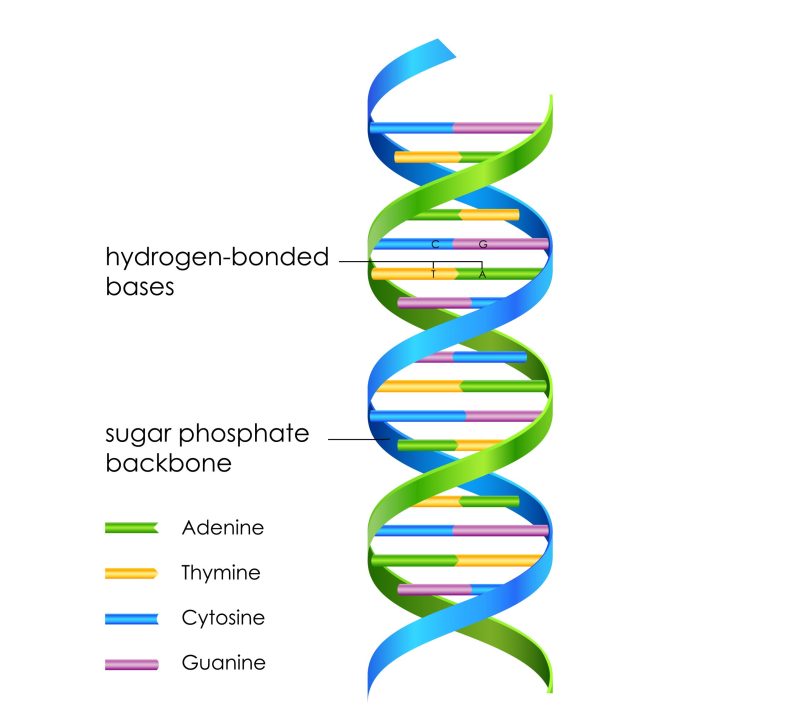What are molecular biology and genomics?
The definition of molecular biology
When we hear the term “molecular biology”, we frequently think of living beings, plants, animals, and so on, since we tend to focus on the word biology rather than the word molecular. But what exactly does the term ‘molecular’ mean? When looked at in a dictionary, molecular is defined as “relating to, consisting of, or produced by molecules”. This does not help much, does it?
Biology, like any other scientific field, is separated into several disciplines based on the characteristics of each field. When referring to molecular biology, we talk about the study of the chemical and physical structure of macromolecules, as well as the interactions between them. But now you are wondering: “What exactly is a macromolecule?”. Chemistry is the study of the atoms that make up the elements and matter. Biology is the study of living beings. So molecular biology is the discipline that encompasses the little pieces that makeup living creatures, known as macromolecules, which are larger than an atom or an element but smaller than anything else. Here macromolecules describe proteins, nucleic acids (DNA), carbohydrates, etc. They are the basic components of all living things and are everywhere!
We can understand the fundamental mechanisms underlying any process we want by studying the structure, function, and interaction of macromolecules inside all living organisms such as a disease, a metabolic process, the growth of a specific organ, the production of a basic component (such as insulin), and so on.
What is DNA?
Let us now introduce ourselves to the world of molecular biology, and for that, we need to understand the basic molecules or parts that are studied in this discipline. One of the most important is the ‘DNA’. Deoxyribonucleic acid (DNA) is the fundamental material that encodes every feature and function in the human body and almost all other species.
DNA is made up of a set of chemical bases called Adenine (A), Guanine (G), Cytosine (C), and Thymine (T), which combine to generate the instructions for producing all of the proteins in our body. It is analogous to a "code" in informatics or a "recipe" in cooking. To make nucleotides (fundamental building blocks of DNA), each base is additionally connected to a sugar and phosphate molecule (you can observe the same in the DNA picture).

The DNA molecule has a distinct "double helix" form in which these bases engage in precise pairings (A-T, C-G) to keep the molecule together, much like a twisted ladder. The interacting bases would be the ladder's steps, while the sugars would be the handrail.
An important characteristic of DNA is that it can replicate, which means it can make copies of itself. This is critical because as cells divide, the genetic material must be passed on to the “daughter” cells in order to preserve the same features and information throughout the organism. What if you chopped a branch off a tree and the one that grew back had different types of leaves and a distinct wood pattern than the rest? It would be strange, wouldn't it? As a result, the genetic material must be replicated and passed on to new cells each time.
Genes and the genome
Now that we have figured out what DNA is, let us talk about what is coded in it. The answer is genes!
The genes are analogous to the names of the recipes encoded in the DNA. Each one codes for a distinct product (a protein), and they are all encapsulated in the cell's genetic material. The genome is defined as the complete set of genes, or genetic material, present in a cell or organism. It basically contains all the information that all living creatures need to function properly.
In a nutshell, when a cell decides that it needs to produce a specific protein, it goes to the genome for instructions (our cooking book). It searches for the necessary genes (the recipe's chapter) and then reads the information recorded in the DNA (the written recipe). When this information has been processed, there is a new protein in the cell that is ready to start performing a specific function.
Importance of molecular biology
Scientists examine the genome and genes to study how different proteins are generated in the cell. In addition, they also study how these products interact with one another and with molecules outside the cell. Hence, molecular biology is a field that focuses on these interactions and the networks that form in the bodies of living organisms such as plants and humans.
When a meal is cooked and ready, it is not just about the components that go into it, but also about how it was prepared, presented, and consumed to gain the entire experience and understanding of it. The same is true for the proteins and other chemicals found in our bodies and in plants. To have a complete understanding of a certain molecular process, it is necessary to understand not only how they are generated (DNA), but also how they interact with one another and with their surroundings. That is the focus of ‘molecular biology’. Bon appétit!
For more interesting articles in the sphere of plant science and molecular biology, keep checking this space.
By Victoria Puértolas | 28 June 2022
References
- Davis, L. G., Dibner, M. D., Battey, J. F., & Elsevier Science & Technology (Firm). (1986). Basic Methods in Molecular Biology. Elsevier Gezondheidszorg.
- Tabery, James, Piotrowska, M., & Darden, D. (2019, 27 junio). Molecular Biology (Stanford Encyclopedia of Philosophy/Spring 2021 Edition). https://plato.stanford.edu/. https://plato.stanford.edu/archives/spr2021/entries/molecular-biology/
- Tait RC. The application of molecular biology. Curr Issues Mol Biol. 1999;1(1-2):1-12. PMID: 11475693.
- What is DNA?: MedlinePlus Genetics. (2021, 19 junio) Https://Medlineplus.Gov/. https://medlineplus.gov/genetics/understanding/basics/dna/
- What is DNA? (2021, 21 julio). Yourgenome. https://www.yourgenome.org/facts/what-is-dna
